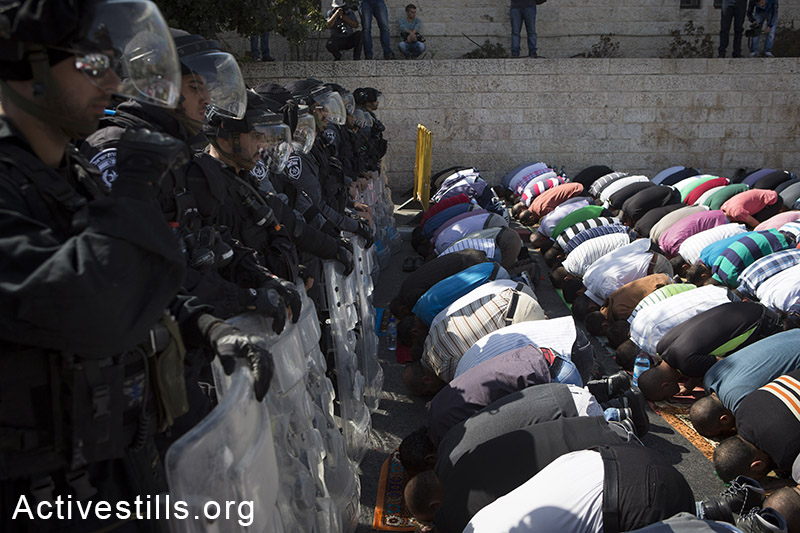The absence of an affirmation of Judaism’s connection to the Temple Mount/Haram al-Sharif is being exploited to distract from Israeli violations of the status quo, and restrictions on Muslim-Palestinian access to the holy site.
By Tom Pessah

Anti-Semitism, for Netanyahu and much of the Israeli and Jewish press, is clickbait. Mention it and you can all but guarantee almost automatic outrage. Just like advertisers can avoid talking about why a car is expensive by using sexual imagery or even the word “sex” to sell it, the Israeli government can dodge difficult questions about its policy by “anti-Semitizing” those who raise these questions.
UNESCO passed a resolution regarding holy Muslim sites in Jerusalem on Thursday. After “affirming the importance of the Old City of Jerusalem and its Walls for the three monotheistic religions,” the resolution calls for the restoration of the previous status quo around “Al-Aqṣa Mosque/Al-Ḥaram Al-Sharif and its surroundings.”
The resolution notes that Israel is violating Muslims’ freedom of worship by hindering and preventing their access to the Aqsa Mosque; “deplores the continuous storming” of the mosque compound by Israeli right-wing extremists and uniformed forces; decries arrests and injuries of Muslim worshippers in the mosque; and “[r]egrets the damage caused by the Israeli forces, especially since 23 August 2015, to the historic gates and windows of the al-Qibli Mosque inside Al-Aqṣa Mosque/Al-Ḥaram Al-Sharif, and reaffirms, in this regard, the obligation of Israel to respect the integrity, authenticity and cultural heritage of Al-Aqṣa Mosque/Al-Ḥaram Al-Sharif, as reflected in the historic status quo, as a Muslim holy site of worship and as an integral part of a world cultural heritage site.”
In a parallel universe, the Israeli prime minister could have promised to do more to uphold Muslims’ freedom of worship and to reassure the Muslim world that Israel is not trying to damage the mosque. Those are real and important issues. Instead, Netanyahu’s reaction was: “to say that Israel has no connection to the Temple Mount and the Western Wall is like saying that China has no connection to the Great Wall of China and that Egypt has no connection to the pyramids.”
Nowhere in the UNESCO resolution is there any statement invalidating or denying Jews’ connection to Temple Mount: the Jewish connection isn’t discussed in any way, either positively or negatively. It is not mentioned because the resolution is about Israeli damage to a Muslim holy site – Al-Aqsa Mosque. Beyond that there is no general assessment or rejection of any religion’s connection to the site, apart from an affirmation of “the importance of the Old City of Jerusalem and its Walls for the three monotheistic religions.”
Could the resolution have preempted some of the negative reactions with a symbolic mention of the term “Temple Mount?” or by acknowledging that it is also a Jewish holy site? Perhaps, but that’s far from the point.
Netanyahu produced the spin, but Israeli journalists of all stripes were eager to spread it. Broadly quoting an Israeli diplomatic source, Haaretz summarized the resolution as “anti-Israel” and says it “disregards Judaism’s historic connection to the Temple Mount and casts doubt on the link between Judaism and the Western Wall.” Not a word about the restrictions Israel places on Muslims’ access to the site and their right to worship, which the resolution discusses in such detail. The Haaretz report also assumed the resolution made reference to the Western Wall, while in practice it only discusses the “Western Wall Plaza,” built in 1967 by cleansing the residents of what had been the Mughrabi Quarter for almost eight centuries. (The official Israeli name for the Plaza is placed in quotation marks in the resolution, which correctly defines Israel as an occupying power obliged to safeguard the cultural heritage of the areas it occupied. No country has ever recognized Israel’s annexation of East Jerusalem, an area that includes the Old City, Western Wall and Haram al-Sharif/Temple Mount.)
The spin even affected Zehava Galon, head of the left-wing Meretz party. Reproducing the Haaretz photo on her Facebook page, Galon wrote that UNESCO “cannot erase years of Jewish history.” Israeli President Rivlin responded by asserting that “no forum or body in the world can say there isn’t a connection between the Jewish People, the Land of Israel and Jerusalem,” reacting yet again to a declaration that was never made. And so on and so forth.
Most importantly, the entire discussion focused on something UNESCO has no power to do – it does not have any power to nullify the Jewish connection to Jerusalem or any holy sites, even if it wanted to. The real-world power to shape the status quo in Jerusalem rests solely in the hands of Israel, not UNESCO. It is what Israel does with that power which we should be focusing on.
Is there a moral to this story? Perhaps the lesson is that just like consumers of online clickbait, we have a choice. We really don’t have to click on a link that says SEX in capital letters. And we really don’t have to help propagate Netanyahu’s spins, which as usual are designed to draw attention away from the real, physical harm that the Occupation is causing.
Tom Pessah is a sociologist and activist.
